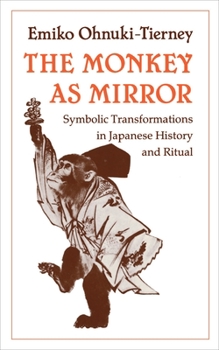The Monkey as Mirror: Symbolic Transformations in Japanese History and Ritual
Select Format
Select Condition 
Book Overview
This tripartite study of the monkey metaphor, the monkey performance, and the 'special status' people traces changes in Japanese culture from the eighth century to the present. During early periods of Japanese history the monkey's nearness to the human-animal boundary made it a revered mediator or an animal deity closest to humans. Later it became a scapegoat mocked for its vain efforts to behave in a human fashion. Modern Japanese have begun to see a new meaning in the monkey--a clown who turns itself into an object of laughter while challenging the basic assumptions of Japanese culture and society.
Format:Paperback
Language:English
ISBN:069102846X
ISBN13:9780691028460
Release Date:April 1989
Publisher:Princeton University Press
Length:288 Pages
Weight:0.75 lbs.
Dimensions:0.8" x 5.5" x 8.5"
Related Subjects
Anthropology Asia History Japan Politics & Social Sciences Social Science Social SciencesCustomer Reviews
1 rating
An excellent text.
Published by Thriftbooks.com User , 26 years ago
The 'Monkey as Mirror' is a book written ethno-historically dealing with social-cultural anthropology. The main concerns of the text are "the relationship between culture and history on the one hand and that between history and ritual/performance on the other". The main concern of the book is to examine the cultural progression of the Japanese. In order to analyze this, the focus resides on the monkey performance and Special Status People (SSP) posing as symbolization and transformation as a result of changes in Japanese society.The text is very well set out and follows strategic guidelines as presented in the contents, this effectively links the book and ties the reader into its structure. As well as having a colorful and imaginative title, carrying with it the mischievousness associated with the macaque/baboon image, use has been made of folklore and myth in order to add entertaining and comical enjoyment to the text. This is also carried throughout the t! ! ext by the authors excitement when giving descriptions of monkey performances and training sessions. Footnotes are used to illustrate details of such things as ceremonies, rituals, customs, myths and legends as required. This allows the reader to identify with the cultural history of the Japanese whilst simultaneously offering explanation to non-Japanese readers. This allows for a better understanding of the rituals presented in the text and opens up an avenue of further reading for concepts brushed upon but not discussed in detail by the author. The use of identifiable language throughout the text allows access to a broad readership base. As the text unfolds self-criticism is made, making one feel as though the author is being a little more honest and reliable than we may necessarily believe.The author perceives that in modern day Japan religious meanings of the monkey performance have remained, but the sense for the need of ritual has been lost. The crux of the text is th! ! at the monkey continues to be seen as a trickster, yet new ! notions of the 'cultured monkey' have arisen endorsing an attitude representing progressive, modern Japan: "speak out, examine, and listen". Ohnuki-Tierney presents the impression that emphasis has now been placed on the Japanese self as the 'cultured monkey' and others as 'tricksters'. The text illustrates the three 'cultured monkeys' as representative of contemporary Japanese society, covering the belief that the monkey represents a confronting force for contemporary society, questioning and mocking its very framework. Showing the monkey as a group animal associating it with the yin-yang (reflexive) notion and view of the Japanese as 'self' and foreigners as 'others', the monkey becomes a culturally important animal. The author expands upon this by looking at duality in the reflexive nature of Japanese society. A whole chapter is devoted to this principle assuming the reader to have no knowledge of the concept. Yet when looking at the representations of mo






